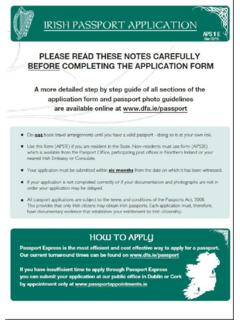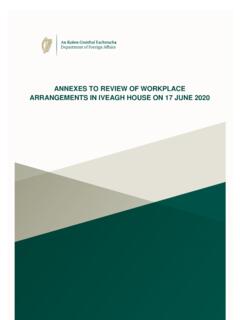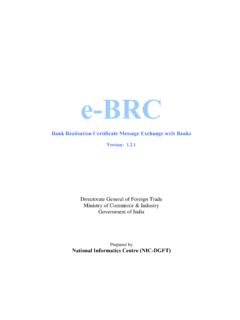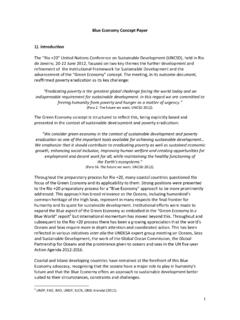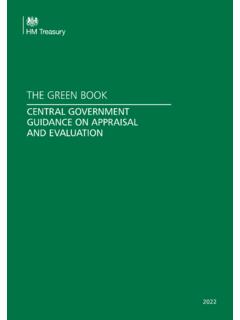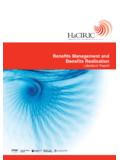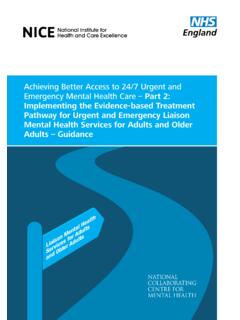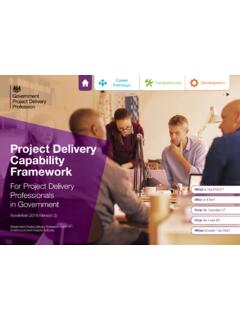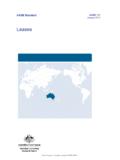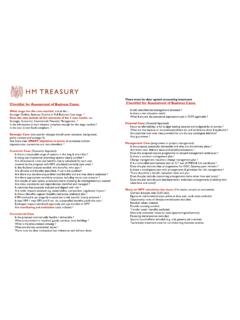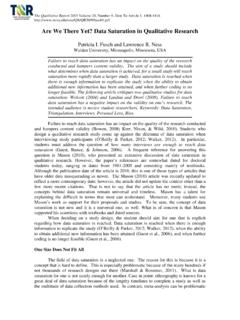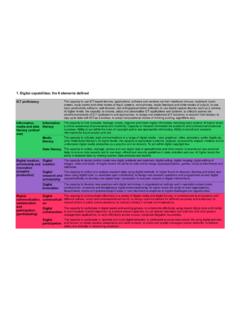Transcription of Ireland and the EU: A History - dfa.ie
1 1950 - 1973(Sept.) Ireland signs the EuropeanPayments Union Agreement.(May) Schuman Declaration on poolingFranco-German coal and steel (Feb.) The ECSC comes into INTEGRATION(Apr.) Treaty of Paris signed by France,West Germany, Italy, Belgium, Holland andLuxembourg (the Six) creates the EuropeanCoal and Steel Community (ECSC).1951(Dec.) Ireland is admitted to the UnitedNations.(June) The Messina Conference agrees toencourage free trade between ECSC members through removing tariffs (May) The foreign ministers of the Six openintergovernmental negotiations towardsTreaties establishing a European EconomicCommunity (EEC) and a European AtomicEnergy Community (EURATOM).1956(Aug.) Ireland joins the IMF and the WorldBank.(Mar.) Treaties of Rome signed as the firststep towards establishing the (Nov.) Programme for Economic Expansionlaid before the Oireachtas.(Jan.) Foundation of the EEC and (June) Se n Lemass (FF) elected (July) Ireland applies for EEC membership.
2 (Aug.) Britain and Denmark apply for EECmembership.(Oct.) European Commission announcesnegotiations should be opened with Irelandfor full membership of the (Aug.) Second Programme for EconomicExpansion.(Jan.) De Gaulle vetoes Britain s EECapplication Ireland s EEC application goesinto cold (Oct.) Harold Wilson (Labour) replaces SirAlec Douglas Home (Conservative) asBritish Prime (Dec.) Anglo-Irish Free Trade AreaAgreement (AIFTAA) signed.(Apr.) The Merger Treaty is signed inBrussels. It merges the executives of theECSC, EEC, and Euratom to becomecollectively known as the EuropeanCommunities (EC).1965(July) Anglo-Irish Free Trade Area comesinto being.(Nov.) Jack Lynch (FF) replaces Se nLemass (FF) as Taoiseach(Nov.) Wilson tells House of Commons thatBritain is exploring the possibility ofjoining (May) Ireland s second application for ECmembership.(May) Britain, Ireland , Denmark andNorway apply for EC membership.(May) de Gaulle s velvet veto of Britain ssecond EC application.
3 (Dec.) European Commission announcesthat it is not proceeding with Ireland s (Mar.) Third Programme, Economic andSocial Development, 1969-72.(June) Patrick Hillery replaces Frank Aikenas Minister for External Affairs.(August) Outbreak of the Troubles inNorthern Ireland .(Apr.) De Gaulle resigns.(Dec.) Hague Summit reaffirms theagreement of the Six to the enlargement ofthe (June) EC entry negotiations formally openwith Ireland .(June) Edward Heath (Conservative)replaces Wilson as British Prime (May) Referendum on EC entry passed by alarge majority.(Jan.) Denmark, Ireland , Norway and theUnited Kingdom sign the Treaties ofAccession to the European (Jan.) Ireland joins the EC.(Jan.) Britain and Denmark join the |Jean Monnet andRobert Schuman, 9 May1960, 10th anniversary ofthe Schuman Declaration.(European Commission AV Services,P-013586/00-07)Project Credits |This exhibition is a joint project of the NationalArchives of Ireland and the Royal Irish Academy,funded by the Department of Arts Heritage andthe GaeltachtExhibition Co-ordinator: Catriona Crowe (NAI)Text: Dr Michael Kennedy (RIA) Research: Dr Eoin KinsellaDesign: Ger GarlandScanning: Eamonn Mullally (NAI)Thanks toMr Brendan Delaney (ESB) Dr Michael Geary (University of Maastricht) Mr Gerry Hampson (ESB) Ms Elizabeth Harford (NLI)Mr Seamus Helferty (UCDA) Mr Jason Kelleher Ms Ciara Kerrigan (NLI)Ambassador Se n KennanMs Ita McAuliffe (Labour Party)Ms Frances McGee (NAI) Ms Laura Mahoney (RIA) Ms Irene Stevenson (Irish Times)Ms Maureen Sweeney (Dept.)
4 Of Foreign Affairsand Trade)Department of Foreign Affairs and Trade University College Dublin, Archives Department The Irish Times European Commission Audiovisual Services Electricity Supply Board ArchivesF ilte IrelandIrish Railway Record Society David Burke (Fianna F il)Mr Alan KinsellaSinn F |Signature of theTreaties of Rome, creatingthe EEC and EURATOM, 25 March 1957.(European Commission AV Services,P-001321/00-05)above |Signature of theTreaty of Paris, creating theEuropean Coal and SteelCommunity, 18 April 1951.(European Commission AV Services,P-002720/00-1)above |Se n Lemass andJack Lynch at Dublin Airportbefore boarding a flight toLondon for tradenegotiations (1961).(Michael Kennedy personal collection)below |Taoiseach JackLynch, Minister for ForeignAffairs Dr Patrick Hilleryand the Irish negotiatingand accession team,Brussels, 1972.(UCDA P205/182)above |Taoiseach JackLynch and Minister forForeign Affairs Dr PatrickHillery sign Ireland saccession to the EuropeanCommunities, Brussels, 22 January 1972.
5 (European Commission AV Services,P-011619/00-09) THEBACKGROUNDTO Ireland SFIRST EECAPPLICATION 1950-1961 We might find ourselves a political,as well as an economic, anachronismin the midst of the world s largestpolitical and economic entity Department of Finance memorandum, June 1961.(NAI DFA CM 15/1)In May 1950 the first chapter of European integration, theFranco-German Schuman Declaration leading to the EuropeanCoal and Steel Community (ECSC), passed Ireland by. On theperiphery of Europe Ireland looked inwards, protective of itspolitical sovereignty and believing in economic self-sufficiency,its industries hidden behind protective tariff barriers. WhileEurope enjoyed the benefits of post-war economic growthIreland 1957 the second chapter in European integration beganwith the Treaty of Rome and its creation of the EuropeanEconomic Community (EEC) and the European Atomic EnergyCommunity (EURATOM). Ireland s fortunes had not and emigration were rising, and with lacklustreeconomic growth forecast, Ireland s future seemed was not invited by the six original members of theEEC to join them and seemed likely to remain outside its Common Market.
6 Experts planning to develop the Irisheconomy settled on a model of economic development throughexport led growth. The protected Irish economy, in particular itsdominant agricultural sector, would be opened up to foreignmarkets. Ireland would embrace free trade and of the EEC became a key foreign policy goalof Fianna F il Taoiseach Se n Lemass from the moment hetook office in 1959. Europe moved to the centre stage of Irishforeign policy. Lemass believed that Ireland s economy wouldprosper within the EEC. He was particularly keen on EEC plansto develop a Common Agricultural Policy (CAP) as its priceguarantees and export subsidies would suit the agriculturallydominated Irish s new export-led economic policy began to GNP grew by over 4% in 1959 and 1960. Ireland needed toexpand its foreign trade further. But was Ireland sufficientlyeconomically developed to withstand the impact of free tradeand competition that EEC entry would bring? Could Ireland jointhe EEC if Britain, its main trading partner, did not?
7 Aware thata British application was becoming a distinct possibility, inJuly 1961 the Lemass government published a White Paper onthe EEC and let its six member states know that in the event ofBritain applying for EEC membership Ireland would also |Ambassador toBelgium Frank Biggarpresents his credentials asIreland's Chief of Mission tothe EEC to President of theEuropean CommissionWalter Hallstein, Brussels,24 February 1961.(European Commission AV Services P-009247/00-1)above |Round table of theFirst European left to right: Ren e vanHoof (interpreter); GiuseppePetrilli; Jean Rey; PieroMalvestiti; Hans von derGroeben; Walter Hallstein;Emile No l; RobertLemaignen; Robert Marjolin;Lambert Schaus, Brussels,1960.(European Commission AV Service P-008949/00-1)below |Minister for ExternalAffairs Frank Aiken withGerman Chancellor KonradAndenauer, Bonn, August1960.(UCDA P104/8264)THE FIRSTAPPLICATION July 1961 - January 1963 The political aims of the Communityare aims to which the Irish governmentand people are ready to subscribe andin the realisation of which they wish toplay an active part Speech by Lemass to the European Commission, 18 January1962.
8 (Agence Europe, no. 1169) Ireland applied for full membership of the EEC on 31 July membership was ruled out as it suggested thatIreland was economically underdeveloped. The application wassent as British Prime Minister Harold Macmillan announced thatBritain would also apply for EEC European Commission s response to Dublin did notindicate when Ireland s EEC entry negotiations might in Brussels thought Ireland sufficiently developedeconomically for EEC membership. Some did not take Ireland sapplication seriously, not expecting an Irish application separateto Britain s. Irish neutrality and non-membership of NATO werealso problematic in light of moves for European politicalintegration after the July 1961 Bonn Declaration. The Communityexamined the British and Danish applications, leaving Ireland addressed the Community s fears directly in aspeech to the European Commission in January 1962. In October1962 he visited the capitals of the Six to emphasise that Irelandwas sufficiently economically developed to join the EEC andthat Ireland s military neutrality and non-membership of NATO were not obstacles to entry.
9 Lemass s personal diplomacy brokethe deadlock. In October 1962 the EEC Council of Ministersagreed to open entry negotiations with Dublin on the basis offull of the Six were in favour of opening negotiations, butFrance remained hesitant, despite de Gaulle giving Lemass theimpression of being well disposed towards Ireland . Britain sentry negotiations took priority and Ireland s negotiations wouldhardly begin before March on 14 January 1963 French President General deGaulle raised doubts over Britain s suitability for EEC membershipand vetoed London s application. Ireland s EEC application waswithin the collateral damage of de Gaulle s Non . The FrenchPresident did not veto Ireland s application, but with its maintrading partner destined to remain outside the EEC there was nopoint in Ireland going it alone. For the foreseeable future EECmembership was out of reach and Ireland would adopt adignified wait and see attitude towards |Letter from EmilioColombo to Se n Lemassannouncing the EuropeanCouncil of Ministers intention to open accessionnegotiations with Ireland .
10 (NAI DT S17339/62)below left |Note forMinister for External AffairsFrank Aiken on theimplications of EECmembership for Ireland sattitude to NATO, 9 January1962 .(NAI DT S16877X/62) below right |Letterannouncing Ireland s desireto apply for EECmembership from Se nLemass to President of theCouncil of the EEC, LudwigErhard, 31 July 1961.(NAI DT S16877X/62)overlay | Ireland is joiningthe for politicalreasons - Lemass.(Irish Times, 24 October 1962)below |Se n Lemass andJack Lynch at Dublin Airportbefore boarding a flight toLondon for tradenegotiations (1961).(Michael Kennedy personal collection)below |Georges Pompidou,Charles de Gaulle andMaurice Courve de Murville,10th Anniversary of theSignature of the Treaties ofRome, March, 1967.(European Commission AV ServicesP-002873/04-9)below overlay | Ireland andthe Common Market - WhatThe Hell Are We Doing AboutIt?(Irish Times,24 June 1966) overlay above |FranceCloses the Door of the EEC.(Irish Times, 20 December 1967)above |Sicco Mansholt(European Commission(Agriculture), Frank Aiken,Ambassador Frank Biggarand Jean Rey (EuropeanCommission (ExternalRelations)), Brussels,November 1963.)
